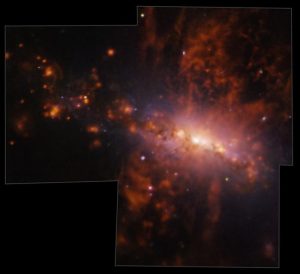KABOOM! Galaxy Pollution in Action
International researchers studied galaxy NGC 4383 in the nearby Virgo cluster and found a gas outflow so large that it would take 20,000 years for light to travel from one side to the other. The discovery is published in the journal Monthly Notices of the Royal Astronomical Society.
Dr. Adam Watts, from The University of Western Australia node at the International Centre for Radio Astronomy Research (ICRAR), indicated that the outflow is the result of powerful stellar explosions in the central regions of the galaxy that could eject enormous amounts of hydrogen and heavier elements. The mass of gas ejected is equivalent to more than 50 million Suns.

Credit: ESO/A. Watts et al
Gas outflows are important in regulating how fast and for how long galaxies continue to form stars. The gas ejected pollutes the space between stars within a galaxy and even between galaxies and can float in the intergalactic medium indefinitely.
In this case, the high-resolution map was produced with data from the MAUVE survey, co-led by ICRAR researchers, and the survey used the MUSE Integral Field Spectrograph on the European Southern Observatoryʼs Very Large Telescope, located in northern Chile.

